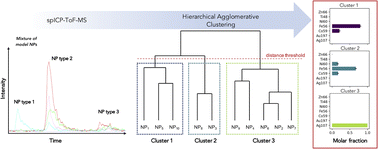Nanoparticle identification using single particle ICP-ToF-MS acquisition coupled to cluster analysis. From engineered to natural nanoparticles†
Abstract
In this study, mono-, bi-, and tri-metallic engineered nanoparticles (ENPs) are first analysed using an ICP-ToF-MS in single particle mode. The method is also used to characterize natural NPs (NNPs) (i.e. oxide and clay minerals). We provide here the elemental composition and mass distribution of these different NPs. For the first-time using spICP-ToF-MS, the presence of Ti- and Si-NPs as well as that of a second population with a distinct Si–Al ratio is highlighted in kaolinite. Finally, for mixtures of the different original NPs, an automated post-processing approach based on hierarchical agglomerative clustering (HAC) is applied. The elemental signature of the different clusters is in agreement with the results of previous characterizations. This illustrates the applicability of coupling spICP-ToF-MS with HAC to determine elemental fingerprints of NPs and to differentiate one from the other when mixed. The described methodology could be a starting point to simplify the analysis and make reliable interpretations of unknown NP populations and thereby more accurately understand NP populations in natural systems. However, as illustrated, thorough evaluation of the data must be performed in order to avoid misclassification of the NPs in future studies.

- This article is part of the themed collection: Fast Transient Signals – Getting the most out of Multidimensional Data


 Please wait while we load your content...
Please wait while we load your content...